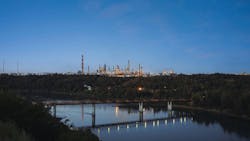Imperial’s Strathcona refinery begins renewable fuels production
ExxonMobil Corp.’s majority owned affiliate Imperial Oil Ltd. has formally commissioned its long-planned grassroots renewable diesel production complex at the operator’s 196,000-b/d Strathcona refinery near Edmonton, Alta., in western Canada.
Following recent completion of construction and initial start of operations in July 2025, the Strathcona refinery’s new plant is now producing renewable diesel, Imperial said on Aug. 5.
First announced in 2021 and approved for final investment decision in January 2023, the Strathcona renewable diesel complex will become the largest of its kind in Canada upon reaching full-nameplate production capacity of 20,000 b/d, the operator said.
While Imperial did not reveal details regarding the complex’s current production rates, the company did confirm it is already supplying renewable diesel from the plant to customers in western Canada and Imperial’s own operations in northern Alberta.
Part of Imperial’s commitment to bringing lower-emission fuels to market and making them accessible to Canada’s hard-to-decarbonize industries, the renewable diesel complex uses an unidentified proprietary technology that combines a mix of locally sourced renewable feedstocks such as canola oil and blue hydrogen (hydrogen produced from natural gas with carbon capture and storage technology) received from Air Products Inc. in the production process (OGJ Online, Sept. 6, 2022).
Upon revealing the project in 2021, Imperial said production from the renewable diesel complex at full operation would help reduce greenhouse gas emissions from Canada’s transportation sector by about 3 million tonnes/year, the equivalent of removing more than 650,000 passenger vehicles/year from the road (OGJ Online, Aug. 25, 2021).
Imperial reiterated the new complex was made possible because of beneficial government policy and support, which included incentives from Strathcona County and the governments of Alberta and British Columbia, the latter of which supported the project in the form of credits under its provincial low carbon fuel standard (BC LCFS).
About the Author
Robert Brelsford
Downstream Editor
Robert Brelsford joined Oil & Gas Journal in October 2013 as downstream technology editor after 8 years as a crude oil price and news reporter on spot crude transactions at the US Gulf Coast, West Coast, Canadian, and Latin American markets. He holds a BA (2000) in English from Rice University and an MS (2003) in education and social policy from Northwestern University.

